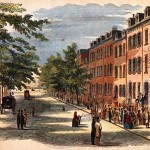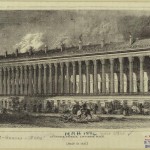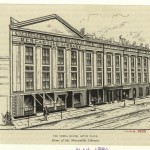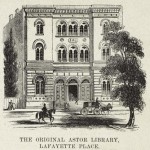The Neighborhood
The Rise and Fall (and Rise) of an Elite Neighborhood
The Bond Street area where Seabury Tredwell moved his large family in 1835 had been attracting the city’s wealthiest and most influential citizens since the 1820s. Broadway, a block and a half west of the Tredwells’ new home, was still a residential street. And just two blocks to the south, Bond Street, lined with row houses of red brick and white marble, stretched for 1,000 uninterrupted feet between Bowery and Broadway.
LaFayette Place (now Street) had been opened from Astor Place to Great Jones in 1826 by John Jacob Astor, who realized the potential of the area as an “uptown address.” The most impressive residential building in the City — La Grange Terrace, also known as Colonnade Row — was built on LaFayette in 1832. A portion of Colonnade Row, now sadly deteriorated, can still be seen today.
- Bond Street, 1857
- Lafayette Place, 1866
- Colonnade Row
- Grace Church, 1843
- Astor Place Riots, 1849
.
Churches soon followed their elite clientele to the neighborhood. By 1846, with the construction of the elegant Grace Church at 10th and Broadway, there were six fashionable churches just steps from the Tredwell home.
As further evidence of the aristocratic nature of the neighborhood, the Astor Place Opera House opened at the juncture of Astor Place and Lafayette in 1847. However, just two years later, in May 1849, the Opera House became the focus of a bloody riot that rocked the city and marked the beginning of the neighborhood’s gradual decline as an exclusive residential enclave.
The Neighborhood Changes
The following year, the Opera House was sold to the Mercantile Library Association, which remodeled the interior and in April 1854 opened the Mercantile Library. With a lecture room seating 1,000, a reading room housing newspapers and periodicals from all over the world, and thousands of volumes available for loan, the subscription library attracted many patrons. By 1865, over 10,000 persons paid the yearly $5 fee for use of the library.
The Mercantile Library was actually the second library to be located in the neighborhood. John Jacob Astor had left a legacy of $40,000 to build a public library for New York City, and just a few months before the Mercantile Library opened, the Astor library began operation. Located across the street from Colonnade Row, it was a research library, attracting scholars from all over the world.
In the same year that the libraries opened, construction began on The Cooper Union at Fourth Avenue and Astor Place. It would be a free school for students who could not otherwise afford advanced training in the practical arts and sciences. It still stands, its exterior virtually unchanged, offering degrees in art, architecture, and engineering.
- Mercantile Library
- The Cooper Union
- Astor Library
.
Because of the cultural and intellectual characters of these institutions and others nearby, neighbors such as the National Academy of Design and the New-York Historical Society, the Bond Street neighborhood began to be known as “the Athenian Quarter.”
By the time Seabury Tredwell died in 1865, the neighborhood was no longer attracting New York’s elite. Bond Street had yielded to commercial development, the Seventh Regiment and the large Tompkins public market occupied a building across from Cooper Union, and the genteel residences on Broadway had been replaced by shops and workrooms.
But it appears Seabury Tredwell saw no reason to change his address just because it was the fashionable thing to do, and after his death, the women of the family may not have had the emotional resources to pull up stakes, for they continued to live in the Fourth Street house for the rest of their lives. When Gertrude Tredwell died in 1933, saloons and manufacturing lofts were her neighbors and the nearby Bowery had achieved notoriety as the nation’s skid row.
Today, the neighborhood is fashionable once again as high-rise apartment buildings and condominiums, chic boutiques, and restaurants have made their appearance throughout the area.










